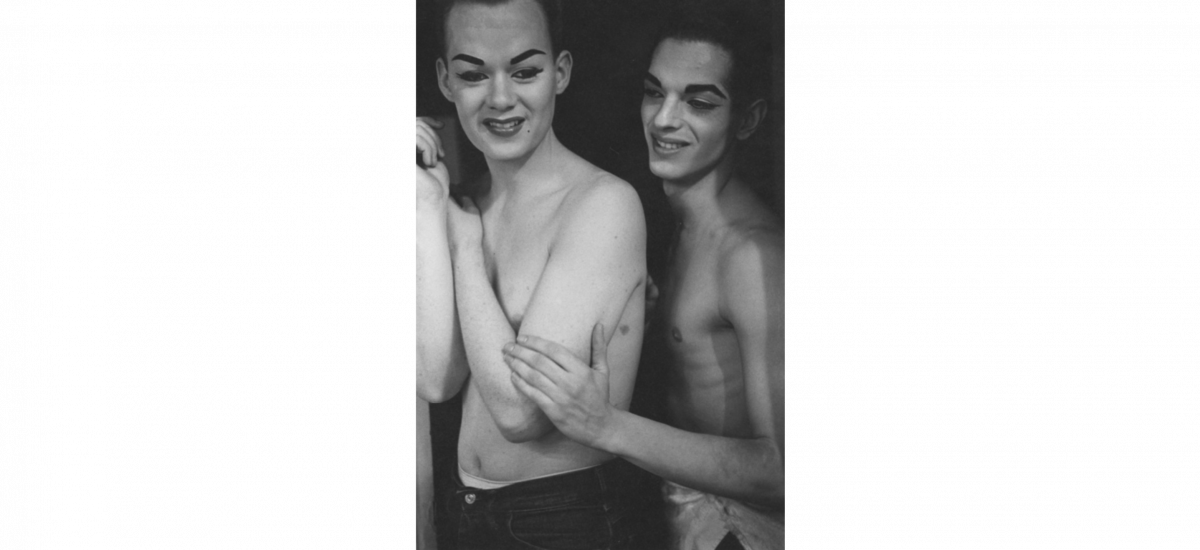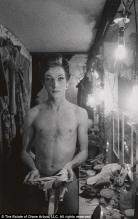It's Okay To Be Yourself
Created by Karli Storm on Mon, 04/01/2024 - 15:56
This timeline provides a sociohistorical context for Dian Arbus's 1962 Two Female Impersonators Backstage

Arbus, Diane. Two Female Impersonators Backstage, N.Y.C.. 1962. https://www.artnet.com/artists/diane-arbus/two-female-impersonators-backstage-nyc-1962-a-QteiKplNmHSJ8IrlVh1gvQ2. Accessed March 28 20204.
Timeline
Chronological table
| Date | Event | Created by | Associated Places | |
|---|---|---|---|---|
| circa. 1920 |
The Drag BallDrag has been around since at least 1388 but the first time the word “drag” was used for the gay culture was not around until the 1920’s. The drag balls began in Harlem’s Hamilton Lodge in New York. This is because New York City is the center of the world’s drag ball culture. Around this time, these drag balls were put on the down low for the reason that the gay community could feel welcome and this building was a safe place where they could all gather and communicate. As the drag balls grew, they were seen as illegal and immortal by society. A moral reform organization known as the Committee of Fourteen later investigated these drag balls because detailing scandalous behavior that was witnessed. By the 1920s, the balls started making more public visibility. The balls were later called “Faggot Balls” because the later public was aware that not only gay people were attending, but by lesbian and transgender people as well. The balls were crucial in the creation and maintenance of the LGBTQ culture. Historian, George Chauncey, pointed out that Harlem enhanced the solidarity of the gay world. However, powering through all the harassment and arrests, Harlem became a “homosexual mecca.” Hoffman, Baylie. “The History of Drag.” Struthers Library Theatre, Struthers Library Theatre, 7 June 2023, www.strutherslibrarytheatre.org/blog/the-art-and-history-of-drag. Accessed March 28 2024. Ball culture. (2024, March 1). In Wikipedia. https://en.wikipedia.org/wiki/Ball_culture. Accessed March 28 2024. Stabbe, Oliver. “Queens and Queers: The Rise of Drag Ball Culture in the 1920s.” National Museum of American History, 16 Apr. 2016, americanhistory.si.edu/explore/stories/queens-and-queers-rise-drag-ball-culture-1920s. Accessed March 28 2024. |
Karli Storm | ||
| circa. 1950 |
Gay Is GoodIn the 1950s, individuals who did not conform to the societal norms of gender or sexuality were often subjected to stigmatization and persecution through legal ramifications and labeling as "deviants" with terms like "homosexual" or "invert". Despite this, early advocates for LGBTQ rights adopted the term "homophile" and responded to this oppression with innovative resistance. World War II brought together many people around the country because many were leaving for the war. Among these millions of people were the gays and lesbians who put aside their kinships on military bases around the world. These people were scared to show their real identity because it could possibly get them dishonorably discharged or even court martialled. However, thousands of people in the military and civil servants were fired because of being homosexual. The military developed homosexual punishments during World War II. The idea of blackmailing was harder because few homosexuals were positioned to not talk about their identity. Following World War II, homosexuals were connected directly to communism. The Cold War gave rise to Senator Joseph McCarthy who was targeting "deviants" in government and Hollywood, seeking to remove undesirable elements from America. This became known as the "Red Scare" and later the "Lavender Scare." “1950s - Explore a Decade in LGBTQ+ History: Pride & Progress.” Explore a Decade in LGBTQ+ History | Pride & Progress, www.prideandprogress.org/years/1950s. Accessed March 28 2024. |
Karli Storm | ||
| circa. 1959 |
Frailties and FlawsDiane Arbus was an American photographer who started out working with her husband, Allan Arbus. Diane Arbus was very perplexed about how to capture people being their true selves. She took a wide range of pictures from strippers, sideshow performers, and nudists, to transgender sex workers and people with dwarfism. When creating these images, she allowed the subjects to show how they possess a strong sense of identity. Arbus looked up to Lisette Model who taught her to take pictures of more specific things because it would be more general. Arbus wrote, “In a way, this scrutiny has to do with not evading facts, not evading what it really looks like.” Her subjects were about to be themselves while she was taking pictures. They did not have to do a specific pose and they were able to feel comfortable to where they knew she was not going to judge them. Arbus’s goal was to show how people were creating their own identities and by those who were trapped in a uniform that no longer provided security or comfort. However, Arbus’s whole gallery was not shown, the majority of her artwork was kept private until it was published in a monograph by her daughter Doon. Diane Arbus. (2024, March 24). In Wikipedia. https://en.wikipedia.org/wiki/Diane_Arbus. Accessed March 28 2024. “Female Impersonator Holding Long Gloves, Hempstead, L.I.” The Met, 2000, www.metmuseum.org/art/collection/search/651806. Accessed March 28 2024. Palumbo, Jacqui. Revisiting Diane Arbus’s Final and Most Controversial Series, 8 Nov. 2018, www.artsy.net/article/artsy-editorial-revisiting-diane-arbuss-final-cont.... Accessed March 28 2024. MailOline, Hannah Al-Othman For. “Snapshot of a Lost Era: Earliest Pictures by Legendary Photographer Diane Arbus Show How America Lived in the 1950s .” Daily Mail Online, Associated Newspapers, 25 Jan. 2017, www.dailymail.co.uk/news/article-4156030/Photographer-Diane-Arbus-captur.... Accessed March 28 2024.
|
Karli Storm | ||
| 2024 |
The ConclusionThe reason that I offered that background concerning those three events is because it helps me to explain what ‘Two Female Impersonators Backstage, N.Y.C. 1961’ was doing socially/culturally, and/or politically when Diane Arbus created it. Diane Arbus was put in a very high seat. This is because she befriended her subjects, instead of objectifying them. Arbus was known for expanding notions of acceptable subject matter and violating canons of appropriate distance between photographer and subject. This photo was taken in 1957 and shows a protest because of the government's persecution of the LGBTQ community. In the picture, Frank Kameny was just fired by the United States Army in the first legal proceedings. Kameny appealed his firing through the courts before he was turned twice. Kameny's pushback against the U.S. Government's policy on homosexual employees was the first of its kind from a gay man. He then argued through written letters and eventually through the courts that the government's discrimination on the basis of sexuality is no different from discrimination based on race or religion. This relates to Diane because she is one to not judge and be okay with Frank’s identity. Diane Arbus’s ability to find people who were creating their own identity was not hard. People ask, why did she chose to train her lens repeatedly on people who were vulnerable. This is because she proclaimed her love for photographing “freaks.” She sought out people with unusual stories to seek out their strangeness and capture it for her collection. Frank Kameny. (2024, March 24). In Wikipedia. https://en.wikipedia.org/wiki/Frank_Kameny. Accessed April 1 2024. “1950s - Explore a Decade in LGBTQ+ History: Pride & Progress.” Explore a Decade in LGBTQ+ History | Pride & Progress, www.prideandprogress.org/years/1950s. Accessed March 28 2024.
|
Karli Storm |



